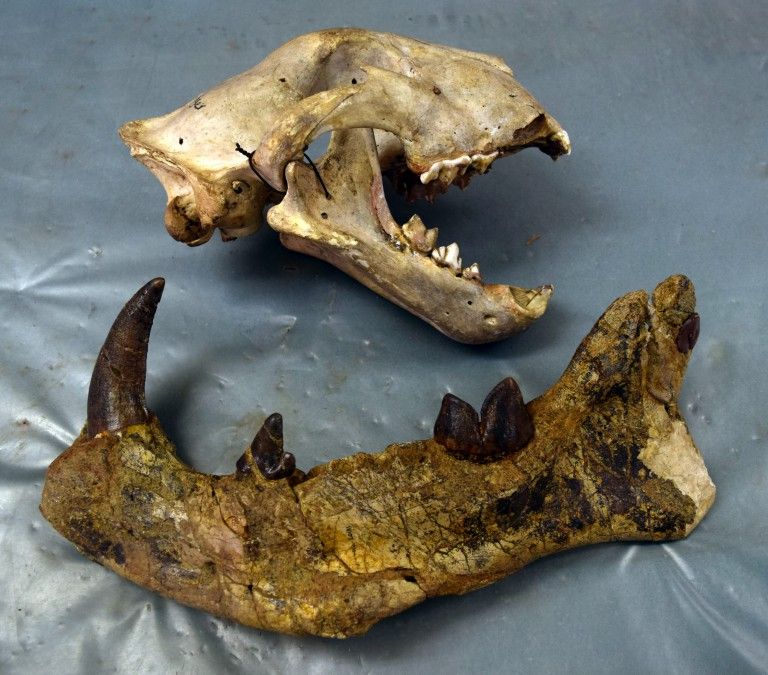This Toothy Carnivore Was Bigger Than a Polar Bear
Some 22 million years ago, the apex predator ruled the forests of Africa and dined on the ancestors of hippopotamuses and elephants
/https://tf-cmsv2-smithsonianmag-media.s3.amazonaws.com/filer/ec/03/ec03578b-595a-4319-a12e-5bb45d74b2c4/simbakubwa-reconstruction-768x559.jpg)
Around 22 million years ago, a giant carnivore with three sets of meat-slicing teeth—comparatively, Catherine Zuckerman points out for National Geographic, all modern carnivores have just one pair—ruled the African forests as an apex predator. Standing around 4 feet tall and 8.2 feet long, the 2,200- to 3,300-pound mammal was larger than a polar bear and had a skull bigger than that of a rhinoceros.
Despite boasting such formidable physical characteristics, the creature, newly dubbed Simbakubwa kutokaafrika, or Swahili for “big lion from Africa,” eventually went extinct under now-unknown circumstances, disappearing from the scientific record until the late 1970s to early ‘80s. As George Dvorsky reports for Gizmodo, researchers searching for evidence of ancient apes at Kenya’s Meswa Bridge site instead unearthed fossils belonging to S. kutoaafrika. These remains, including cheek bones, upper and lower teeth, jaw bones and claws, were consigned to storage at the National Museums of Kenya, where they languished unstudied for more than 30 years.
In 2010, an Ohio University paleontologist named Nancy Stevens chanced upon the fossils while looking through samples housed at the Nairobi facility. Intrigued, she kept the fossils in the back of her mind until 2013, when Matthew Borths, then a research fellow at Ohio University and now curator of the Division of Fossil Primates at North Carolina’s Duke Lemur Center, discovered the same storage drawer and expressed interest in analyzing the unusual specimens. The results of the pair’s subsequent collaboration, recently published in the Journal of Vertebrate Paleontology, offer valuable insights on a group of extinct mammals called hyaenodonts.

According to Newsweek’s Hannah Osborne, hyaenodonts were the first carnivorous mammals to populate Africa. They emerged around 66 million years ago, just after the mass extinction that wiped out Earth’s non-avian dinosaurs, and, in Zuckerman’s words, bore a marked “dental resemblance” to hyenas despite being unrelated to the cat-like carnivorans. The group included some of the largest predatory mammals to ever live, Gemma Tarlach writes for Discover magazine, and spread out across the world during the Miocene Epoch, which lasted from roughly 23 million to 5 million years ago.
Live Science’s Laura Geggel notes that S. kutoaafrika was a hypercarnivore, meaning it survived on a wholly vertebrate-based diet. As Borths tells Geggel, the animal would have played a “lion-like role” in its ecosystem, dining on the ancestors of hippopotamuses, elephants and giant hyraxes. “Compared to modern carnivorous mammals,” he continues, “its head would have looked a little too big for its body, like a very toothy Funko Pop figure."
Incredibly, Borths explains to Gizmodo’s Dvorsky, S. kutoaafrika relied on canine teeth the size of bananas to “grab prey” and “palm-sized” teeth at the back of the jaw to carve up meat.
Based on the giant mammal’s bone structure, as opposed to that of hyaenodonts found in India and Pakistan, the researchers posit that the species started out on the African continent and then migrated northward. According to Popular Science’s Kaitlin Sullivan, S. kutoaafrika and its close relatives likely thrived in their new home for millions of years before succumbing to the tumult sparked by plate tectonic movement. As Borths tells National Geographic’s Zuckerman, increased interaction between native African and Eurasian animals “raise[d] all kinds of hell,” destabilizing food chains and ultimately contributing to the hypercarnivore’s extinction.
“Hyaenodonts were remarkably adaptable, but they ultimately went extinct,” Borths concludes to Dvorsky. “With more information we hope we can help conservation biologists conserve modern carnivore populations before they meet the same fate as Simbakubwa’s relatives.”
/https://tf-cmsv2-smithsonianmag-media.s3.amazonaws.com/accounts/headshot/mellon.png)
/https://tf-cmsv2-smithsonianmag-media.s3.amazonaws.com/accounts/headshot/mellon.png)